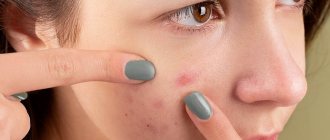To remove acne scars, laser peels and resurfacing are used, but they only slightly improve the situation. It is impossible to completely get rid of acne scars using a laser.
So is it possible to permanently remove acne scars, smooth out craters and smooth out the skin? Or not?
Just a few months ago, not a single clinic could answer that this was possible.
Our surgeon, Maxim Vasiliev, developed his own method. It allows you to quickly remove acne scars almost completely, even out the skin to a healthy level and return it to its natural color.
Only the subcision method can effectively remove acne scars on the face.
Maxim Vasiliev’s method against acne scars is based on the subcision method - a special microtechnique for cutting scars. This method was first used in 1995 and works great even against the most old and deep atrophic scars.
Subcision is a painstaking method of correcting atrophic post-acne scars.
Subcision is performed under local anesthesia using a powerful microscope. Using a sterile syringe needle, the surgeon carefully and quickly cuts the so-called “strands” - separating the scar tissue from neighboring structures. The skin, which is no longer held in place, rises and straightens.
Acne holes
Doctors call noticeable holes in the skin after acne the term atrophic post-acne scars. Their formation is largely due to the inflammatory process that has occurred, which has led to a significant change in subcutaneous fatty tissue, as well as collagen fibers. Often such holes after acne are combined with other changes in the skin, in particular, with the appearance of bluish or purple spots on it.
Fresh scar changes in the skin can be treated quite successfully by a cosmetologist using various medications and treatment methods. However, old post-acne most often can only be slightly corrected, making it less noticeable.
The holes on the face left after squeezing out blackheads are completely different in type and structure. They are abnormally enlarged pores. And getting rid of them is a little easier.
How to remove acne scars on face 100%
Despite the fact that subcision itself shows good results in the fight against scars, it does not provide a 100% effect of smoothing the skin. Removing an acne scar by cutting it is only the first stage.
The second stage is the introduction of a drop of collagen or stabilized hyaluronic acid into the lacuna formed under the crater.
Initially, the injected drug creates the necessary volume and physically “pushes” the scar area to the skin level. Within 6 months, the gel is removed and replaced with its own collagen. Collagen fills the area of the lacuna and takes on the function of maintaining the required volume.
As a result, the craters are significantly leveled with the healthy surface of the skin.
How do scars appear on the face?
Acne or acne is a malfunction of the skin's sebaceous glands, which release excessive amounts of sebum onto the surface of the skin. This functioning of the sebaceous glands provokes the appearance of acne. When pimples are squeezed, the skin is injured and scars appear in areas where the skin is excessively damaged.
After acne goes away, the connective tissue, which is based on collagen, cannot always restore its structure, especially if the inflammation was severe. In this case, a scar appears at the site of the pimple, and the skin texture becomes uneven. You can effectively prevent scars by treating your acne.
If your skin suffers from breakouts, you can protect it from the consequences. Scars on the face may appear in the following cases:
- self-squeezing pimples;
- lack of hygiene;
- sensitive and thin skin;
- the inflammation was furunculous (purulent) in nature;
- infectious inflammation with subsequent infection of the lesion.
Independent mechanical cleansing of the face seriously injures the skin, which entails its uneven relief. If acne removal does occur at home, it is recommended to adhere to the following recommendations:
- The face must be steamed before the acne removal procedure;
- you can squeeze out blackheads and acne only with your fingers;
- After cleansing, the facial skin must be treated with an antiseptic.
It is quite difficult to remove post-acne scars without the help of specialists, but you can try folk remedies or consult a cosmetologist. To avoid scarring, do not squeeze out acne yourself. Hygiene rules must be carefully observed. You can remove traces of inflammation in beauty salons using special procedures. Treatment of acne scars requires patience and perseverance, but the use of modern procedures, medications or folk remedies will help solve the problem.
Photos "before" and "after"
Subcision is the most effective way to treat acne scars. The result “before” and “after” of one procedure. Surgeon: Vasiliev Maxim.
Correction of deep scars. Photos "before" and "after". Completed by: Vasiliev Maxim.
Laser resurfacing of post-acne scars. Performed by dermatocosmetologist Elena Vlasova.
Effective ways to treat scars
Scars and scars are treated in different ways. The specific type of treatment is selected by the doctor depending on the cause, the patient’s condition, concomitant diseases and other factors. The main methods of therapy are:
- Special creams - for example, Imoferase, Dermatix, Naftaderm, Contractubex, Clofibraza, Narbiril and others.
- Chemical peeling - this method is used in cases where treatment with ointments is ineffective.
- Introduction of dermal fillers based on hyaluronic acid or collagen. These components not only smooth the surface of the skin, but also activate collagen synthesis by the body itself.
- Laser therapy can eliminate the most noticeable scars. They are destroyed under the influence of laser radiation, as a result of which collagen synthesis also increases.
- Surgery is indicated in extreme cases when scar tissue needs to be removed. It is possible to transplant a small part of the skin or dermotension.
Getting rid of post-acne using subcision requires patience
Eliminating acne scars on the face using Maxim Vasiliev’s method is a complex and painstaking job. The surgeon works with each scar separately, and one procedure lasts up to three hours. But believe me, the result is worth it.
Expert comment:
“It is almost never possible to remove acne scars in one go.
If the problem is serious, then at one point, one on top of the other, up to five scars and pits are piled up. Sometimes there is less than 1 mm between them. You can't cut everything at the same time. Having lost their point of support, they will all fall at the same time.
Such scars are removed one by one and slowly. Moreover, I schedule each subsequent procedure at least two weeks after the previous one - after the bruises have completely healed.
So it will not be possible to completely and quickly remove acne scars. But it will work out effectively and forever. Agree, this is much more important.”
Maxim Vasiliev, plastic surgeon.
After we get rid of post-acne scars, the work is not finished. The time for perfection is coming.
Prevention Tips
- Wash your face at least twice a day
- Remove makeup before going to bed.
- Don't squeeze your pimples.
- Try to avoid the sun. Always wear sunscreen if you have to go outside.
- Watch your diet. It should be healthy and consist of whole grains, legumes, fresh fruits, vegetables, fish and nuts.
The above-mentioned remedies will help reduce the appearance of scars to a large extent, but nothing will make them disappear completely. Thus, it is best to try to treat acne as soon as possible to reduce the severity of the scars, holes, and pits that follow. And laser scar removal is a very expensive procedure, so it’s better to use natural remedies.
Just getting rid of acne scars on your face is not enough. Removing red spots
The first thing we offer after working with scars is a course of biorevitalization with 3% hyaluronic acid. This procedure very well lightens stagnant spots and evens out skin tone.
Finally, after six months or even a year, the time for the laser comes. The fact that we raised the bottom of the scar almost to the level of healthy skin will save it from aggressive resurfacing. Surface or medium grinding will be sufficient.
Please note that it is not the scar that is polished, but the skin surrounding it: as a result, it partially lowers to the level of the scar. The skin is evened out.
How to get rid of acne marks
COLLOST® gel activates microcirculation processes in the area where there were acne, which helps to quickly eliminate spots that appear after acne. Using the gel will help even out the skin texture and also activate the process of tissue restoration. After using this gel, the skin becomes elastic and its texture is evened out, which is important if you have deep acne scars.
Often medications help make acne defects visually invisible. COLLOST® gel not only copes with this task, but also promotes the rapid formation of new tissue at the site of damage. This product has quality certificates, which confirms the safety of its use. You can undergo a course of procedures with COLLOST® gel in cosmetology centers in your city.
Video:
Laser scar modeling with a fractional erbium laser (laser dermabrasion). The procedure removes scars, “craters” of pores on the skin, and any consequences of post-acne. It is performed under anesthesia; the age of the scars does not matter.
Maria's review:
“When I was young, I suffered a lot from acne. They passed, but by the age of 25 my face had turned into one endless scar. Without exaggeration, white and red scars were piled one on top of the other.
Those who know will understand: even just to leave the house you need to carefully apply concealer, foundation and powder, but as a result you look no better than a young old woman.
There is no quick way to remove acne scars. Unlike acne, they do not go away on their own. Dealing with scars turned out to be more difficult than acne. I burned them out with chemical peels and with a laser - it helped, but I was not able to completely get rid of acne scars.
What I have after a year and a half of treatment with Vasilyev Maxim is very similar to a miracle - there are almost no signs of acne visible, the skin is smooth and beautiful.
How much patience a doctor must have who works for so long with such jeweler precision and brings the work to perfection. Thank you"!
Why do acne scars form?
We are accustomed to the fact that acne and pimples are exclusively a teenage problem that goes away on its own. In fact, this is not true: more than 90% of acne scars leave behind.
Of course, acne marks can be expressed in different ways: for some they are almost invisible, while for others the skin is literally pitted.
To understand how acne scars form, let's remember the structure of the skin. Under the epidermis is the dermis, which in turn consists of two layers - papillary and reticular.
The upper papillary layer is thin. It got its name because of the papillae that connect it to the top layer of skin - the epidermis. Damage to the papillary layer does not threaten us in any way - it is restored without a scar. Damage to the papillary layer is a banal “water” callus, when a delicate pink skin immediately forms under the blister.
The lower layer of the dermis is reticular. This is a thick layer in which blood and lymphatic vessels, sweat and sebaceous glands, nerve receptors, roots and hair follicles are located. It is the reticular layer of the skin that contains collagen and elastane, which make the skin smooth, elastic and even.
After damage, the mesh layer of the skin is not restored. It heals, but always with the formation of a scar. Inflammation in the reticular layer forms acne scars and the skin loses its smoothness.
Chemical peeling
Peeling is the destruction of scar tissue due to the action of various organic acids. They also help optimize fat metabolism, which can also help get rid of acne. There are several types of chemical peeling (depending on the reagent used):
- TCA peeling (using 3-chloroacetic acid with a concentration of 35-50%).
- Retinoic (based on retinoic acid, which not only destroys scars, but also has an antibacterial effect).
- Phenolic (phenol-based - it also helps get rid of scars and destroys bacteria). However, phenol is toxic and can have a bad effect on the nervous system.
Chemical peeling is contraindicated in the following cases:
- recurrence of acne;
- tendency to keloid scars;
- wounds, neoplasms;
- individual intolerance to the substances used.
Laser resurfacing
Laser radiation affects the surface layer of the skin and destroys the tissue that forms the scar. As a result, dead cells are removed and the restoration of healthy tissue is activated. Today, 2 laser therapy methods are used:
- Carbon dioxide laser, based on carbon dioxide, helps remove scars and lighten the affected area.
- The Fracel laser softens scar tissue and enhances collagen synthesis.
The procedure has proven its effectiveness. However, in a number of cases its implementation is contraindicated:
- formation of rough scars (keloid);
- blood clotting problems;
- diabetes;
- mental pathologies;
- exacerbation of chronic diseases;
- all stages of pregnancy and lactation;
- tumors (including benign ones).










